Welcome to “Tips From Sticks-In-The-Mud Woodshop.” I am a hobbyist who loves woodworking and writing for those who also love the craft. I have found some ways to accomplish tasks in the workshop that might be helpful to you, and I enjoy hearing your own problem-solving ideas. Please share them in the COMMENTS section of each tip. If, in the process, I can also make you laugh, I have achieved 100% of my goals.
Recently, I was having trouble with my indoor/outdoor weather station, and I thought low battery power in the outdoor unit might have been the problem. A computer reminder triggers routine preemptive changing of the batteries so that corrosion doesn’t damage the unit. The reminder still had a few months to go, but it has been such a brutally cold winter, I thought the batteries might have aged prematurely.
As it turned out, that wasn’t the problem, which left me with a dilemma: what do I do with these batteries that are probably still good?
Now, the last thing I wanted to do was put them in something that might be destroyed by them. Still, several options existed.
I needed to use a device that would tell me when the batteries were dead, and wouldn’t get missed, allowing the corrosion to ruin the device.
My first thought was a clock. Or clocks. I have several in the garage, so I’m never far from knowing the time. I like staying on schedule, and, even on my time off, my activities are pretty regimented. When a clock with a second hand goes dead, it’s pretty obvious.
Another option was the garage stairs “dinger.” It’s the alert system I use to let me know when visitors are coming down the stairs, a safety system that prevents me from being startled while operating machinery. I’d hate for the table saw blade to spew blood all over company.
Then came another question, “What do I do with these batteries while I’m waiting for them to be used?” I’d have to come up with a storage system.
Previously, I’d made some battery holders for new batteries. The holders are mounted in our laundry room. The garage storage system needn’t use such nice wood, but the job still needed to be done well. Also, I’d have no use for “C,” “D” storage in this system, so a “AAA” and “AA”-only unit would be a quick and easy project. Here’s how I made it:
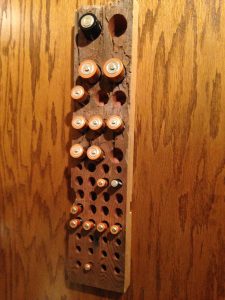
I made this battery storage for our laundry room. Someday, I should put some finish on it. A couple of coats of varnish would look nice.
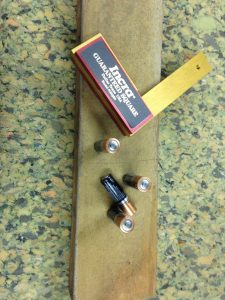
Of course, to keep the project cheap, I chose a scrap piece of wood. My first thought was to use treated pine, but I considered that the chemicals might be corrosive to the batteries or their intended device. The slab needs to be at least 1-1⁄2″ thick to provide sufficient hole depth to prevent the batteries from falling out on their own, or if vibrations shake the wall.
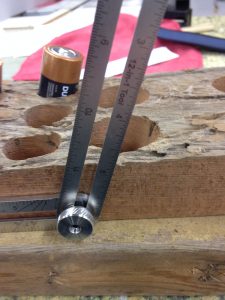
Step two was to decide on a good angle. The Woodpecker’s 12-in-1 Tool says 10i worked well on the previous holder.
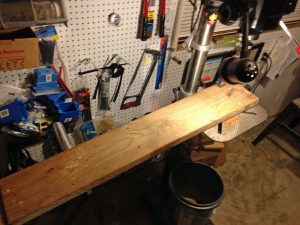
Set the drill press table to 10i with a support you can drill into if necessary. I wanted a long board to support the entire project length.
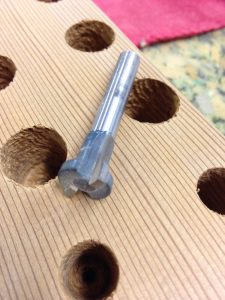
A sharp Forstner bit makes a clean hole with a flat bottom.
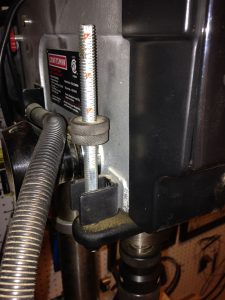
Take the holes to a depth of 1-1/4” for all sizes except D, which needs full-thickness. The depth stop makes for quick and accurate work.
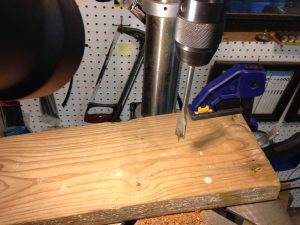
Use 7/16″ diameter for AAA batteries, 5/8″ for AA, 1″ for C and 1-3/8″ for D. You can chisel a rectangular hole for 9-volt batteries, or they will fit in a 1-3/8″ round hole. If there are sizes for which you have no Forstner bit, a spade bit will do, but the hole might not be quite as pretty.
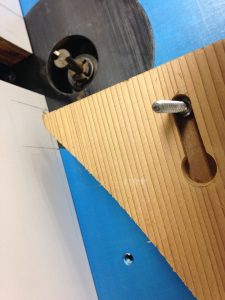
A keyhole bit in the router table makes for an elegant, hidden mounting method.
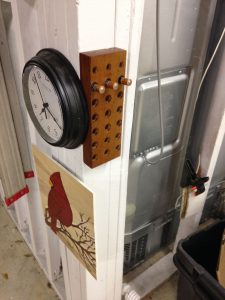
And, the final product, a miniature of the original, right next to one of the clocks its batteries will one day electrify.
Jim Randolph is a veterinarian in Long Beach, Mississippi. His earlier careers as lawn mower, dairy farmer, automobile mechanic, microwave communications electronics instructor and journeyman carpenter all influence his approach to woodworking. His favorite projects are furniture built for his wife, Brenda, and for their children and grandchildren. His and Brenda’s home, nicknamed Sticks-In-The-Mud, is built on pilings (sticks) near the wetlands (mud) on a bayou off Jourdan River. His shop is in the lower level of their home.Questions and comments on woodworking may be written below in the comments section. Questions about pet care should be directed to his blog on pet care, www.MyPetsDoctor.com. We regret that, because of high volume, not all inquiries can be answered personally.

